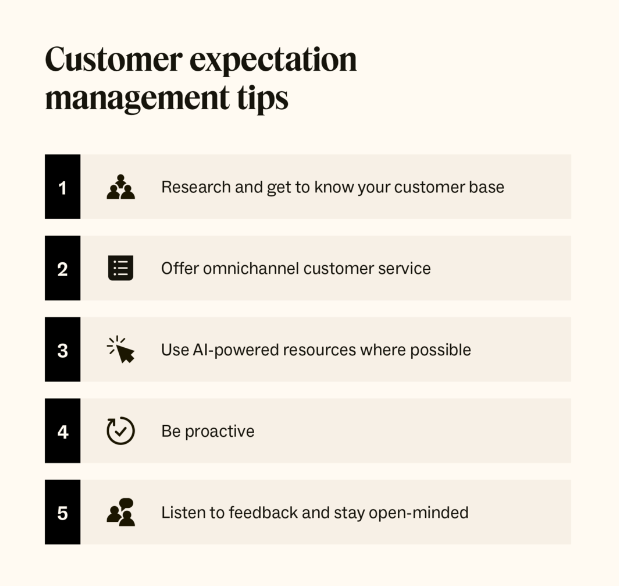We all know that the customer is an important person. Each customer has a different set of expectations. Not all your clients can be on the same page and not every customer’s satisfaction level will be equal. There will not be across the same board, but it takes all of your business running strength to keep your client happy.
73% of consumers are relevant to shift if they have multiple bad experiences. It is not likely that they’ll stick to you. Competitors are waiting for you to make one mistake, and they come running to steal your customer. It is important to prevent your customers with such mistakes and provide them a lifetime experience. And to achieve that, you need to focus on making your organization “customer-first”.
But first things first, what is that customer expectation?
What are customer expectations?
Customer expectations are the set of anticipations and standards that customers have regarding the products or services they receive from a business or organization. These expectations are based on a combination of factors, including
- past experiences,
- advertising and marketing messages,
- word-of-mouth recommendations, and
- the perceived reputation of the company.
Customer expectations encompass various aspects of the customer experience, and they can significantly influence customer satisfaction, loyalty, and the overall success of a business.
Why setting and managing customer expectations is important
Setting and managing customer expectations is basically about making your customers happy. Think about it like this: if you promise to deliver a pizza in 30 minutes, and you actually do it, your customer is going to be pretty pleased.
But if you say 30 minutes and it takes an hour, they’re not going to be thrilled. So, it’s all about being honest and upfront with your customers. When you set clear expectations and then meet or exceed them, your customers are going to trust you, they’ll keep coming back for more, and they might even tell their friends how awesome you are.
Plus, you’ll have fewer angry customers and complaints to deal with, which makes life a lot easier. So, it’s not just about keeping customers happy; it’s also good for your reputation, your bottom line, and your peace of mind.
Here are five paramount reasons for setting and managing customer expectations:
- Customer Satisfaction: Keeping your customers happy and content by meeting their expectations is the foundation of building strong, long-lasting relationships with them.
- Trust and Credibility: Being honest and reliable in your promises helps you earn your customers’ trust and credibility, which is essential for your business’s reputation and growth.
- Customer Loyalty: Satisfied customers are more likely to stick around and keep coming back for more, ensuring repeat business and increased customer loyalty.
- Word-of-Mouth Marketing: Happy customers are your best marketing tool. They’ll share their positive experiences with others, bringing in new customers through positive word-of-mouth recommendations.
- Operational Efficiency: By aligning your offerings with customer expectations, you can streamline your operations, reduce misunderstandings, and ultimately make your business run more efficiently.

10 Tips to Managing Customer Expectations
1. Communicate your product or service offerings
Managing customer expectations is all about being on the same page and avoiding misunderstandings. So, from the get-go, you want to be crystal clear with your clients about what you’re offering. Lay it all out there—what your product or service includes, what it doesn’t, and what they can realistically expect in terms of deliverables, timelines, and costs. But it’s not just about talking; it’s about listening too.
Encourage your clients to share their thoughts and expectations, so you can address any misconceptions or lofty hopes right from the start. And remember, it’s not a one-time thing; it’s an ongoing dialogue. Keep them informed, educated, and updated.
When things change, communicate that too. Plus, if there are hiccups along the way, handle them with grace and empathy. Ultimately, it’s about creating a partnership built on trust and mutual understanding. That’s the secret sauce to successfully managing customer expectations.
2. Understand Your Customers’ Needs
Getting to know your customers and their needs is like putting on a pair of custom-made shoes – it just fits perfectly. So, what you want to do is sit down with your client and really dive deep into what they’re looking for. Ask them about their goals, their preferences, and even any roadblocks or challenges they might be expecting.
This kind of needs assessment isn’t just a formality; it’s your roadmap to offering a solution that’s tailor-made for them. Once you have that inside scoop on what makes them tick, you can align your services or products to meet those specific needs. It’s like being the tailor of customer experiences – and the end result is a happy, satisfied client with shoes that fit like a glove!
3. Establishing project objectives, defining deliverables and setting
Understanding your customers is like having a treasure map to success. You begin by delving deep into demographic information, psychographic traits, and the way they behave as consumers. This isn’t just about collecting data; it’s about gaining valuable insights into what makes them tick. Armed with this knowledge, businesses can craft their products, services, and marketing strategies in a way that perfectly aligns with customer preferences, making for an exceptional customer experience.
But there’s more to it. Customer research isn’t just a one-time thing; it’s an ongoing journey. It helps businesses stay ahead of the curve by spotting emerging trends and anticipating shifts in customer demands.
When you truly get your customer base, you can track the right key performance indicators, offer tailored solutions, and continually fine-tune your offerings to not just meet but exceed customer expectations. In essence, it’s about staying one step ahead, delivering personalized experiences, and always aiming for that “wow” factor.
“It’s essential to have detailed contracts or service agreements that outline the scope of work, project milestones, and any potential changes or additional fees. Having a legally binding agreement helps prevent misunderstandings and disputes down the line.”
-Grant Aldrich, Founder & CEO of Preppy
4. Provide realistic timelines and deadlines
When it comes to setting timelines, it’s crucial to be realistic and practical. Don’t make the mistake of overpromising and creating expectations that can’t be met. Instead, offer timelines that are genuinely achievable, even if they may seem a bit longer.
It’s far better to underpromise and overdeliver than to rush and jeopardize the quality of your product or service. Realistic timelines not only set clear expectations but also ensure that you have the time needed to deliver a high-quality result. So, it’s all about finding that sweet spot where you meet your customers’ needs without compromising on quality or causing unnecessary stress.
“Take the time to educate clients about the process and potential challenges. Provide guidance on what they can do to support the project’s success. Over the years, I’ve observed that informed clients are more likely to have realistic expectations.”
-Tony Mariotti CEO – RubyHome
5. Be transparent about pricing and costs
For pricing and costs, transparency is the name of the game. Be straightforward and upfront with your customers about what they can expect to pay. Hidden fees and unexpected costs can lead to frustration and disappointment.
Spill it all out clearly, detailing the pricing structure and any potential additional charges. This not only builds trust but also ensures that your customers have a realistic understanding of the financial aspect of your product or service. Transparency is the foundation of a strong customer-business relationship, where everyone knows exactly what they’re getting into, and there are no unpleasant surprises down the road.
6. Be proactive in addressing and resolving issues
Being proactive is a game-changer in managing customer expectations. Rather than waiting for customer issues to pile up, take the initiative to get ahead of them. You can do this by identifying common customer problems and then reaching out to customers with solutions before they even have a chance to ask. This might mean using in-product messaging to guide them through common issues, creating how-to videos to make problem-solving easy, or even sending informative emails with best practices.
This not only helps in setting clear expectations but also ensures a smoother and more satisfying experience for both your customers and your team. In this proactive approach, tools like the Churn 360 customer success platform come in handy.
They allow you to seamlessly sync customer data across different systems, ensuring that your support agents are well-informed about support issues and can provide proactive service. It’s all about making your customers’ lives easier and keeping them delighted by staying one step ahead of their needs.

7. Providing status reports addressing concerns proactively and Seeking
When it comes to managing customer expectations, keeping customers informed about the status of their requests or projects is crucial. Don’t leave your customers in the dark; instead, regularly update them on the progress of their inquiries, orders, or concerns. This proactive communication not only keeps your customers informed but also reassures them that their issues are being taken seriously.
Moreover, it’s equally important to actively seek out and address customer concerns before they become major problems. Encourage customers to share their feedback and concerns, and make it easy for them to do so. Whether it’s through website, surveys, feedback forms, or simply being available to listen to their concerns, this approach allows you to spot potential issues early and take swift action to resolve them. By being proactive in these ways, you not only manage customer expectations effectively but also create a smoother and more satisfying experience for your customers.
8. Manage Change Requests
Change requests typically originate from the client or relevant stakeholders. These requests can range from
- new requirements,
- adjustments to existing features, or
- even the removal of certain elements.
It’s important for change requests to be formally documented, providing a clear description of what needs to be changed and the reasons behind the request. This documentation helps in evaluating the impact of the change.
Process for handling change requests
Once a change request is submitted, it’s essential to assess its impact on the project. This involves a thorough evaluation of how the proposed changes affect the project’s scope, timeline, and budget. The project team, including project managers and relevant subject matter experts, reviews the change request to understand what needs to be done, how it aligns with project goals, and what consequences it may have on the project’s overall objectives.
Client approval process
Depending on the project and contractual agreements, client approval may be required for certain changes. The client typically needs to review the proposed modifications and their impact on the project. This review may involve discussions with the client to ensure a clear understanding of the consequences of the change. Once the client is informed and consents to the change, the process can move forward.
Assessing impact on scope, timeline, and budget
With changes in scope, the project timeline may also need to be adjusted. Adding new tasks or features may extend the project’s completion date, while removing work may accelerate the schedule. Project managers need to carefully manage the timeline to ensure that it remains feasible, taking into account the approved changes.
The cost of implementing change requests needs to be estimated, and adjustments to the project budget should be documented. This can result in either additional costs or savings, depending on the nature of the changes. Maintaining a transparent record of budget adjustments is essential for financial accountability.
To gain deeper insights into Churn360, we recommend setting up a demo with one of our experts for a detailed walkthrough
Book a demo
9. Record Keeping and Documentation
Record keeping and documentation are essential for maintaining clear and organized records of customer interactions and business operations. It ensures accountability, regulatory compliance, and the ability to track progress and resolve issues efficiently. Well-maintained records also aid in analyzing past interactions for continuous improvement and serve as a resource for knowledge transfer within the organization.
Additionally, they offer legal protection and evidence in case of disputes. Establishing a structured and accessible documentation system is crucial for effective management of customer expectations and smooth business operations.
“Document all agreements, discussions, and changes in writing. Having a record of communication helps prevent misunderstandings and provides clarity for both parties.” -Ian Sells CEO – Million Dollar Sellers
10. Seek feedback and continuously improve your customer experience
Seeking feedback and continuous improvement is the cornerstone of delivering an exceptional customer experience. Customers often share their feelings and experiences, and it’s crucial to listen with an open mind and resist being defensive. Their feedback can uncover areas where your data collection might fall short and offer a more accurate view of their expectations.
To make the most of customer feedback, ensure your team is well-equipped with the right tools. An internal knowledge base, for example, can simplify the process of categorizing and sharing information across the company, ensuring everyone is aligned and can act on the feedback effectively. This approach not only helps in managing customer expectations but also paves the way for a better customer experience, where customers feel heard and their needs are met.
Final Words
Understanding and managing customer expectations is vital. Use resources like surveys, customer data, focus groups, and social media listening to shape your strategies. Employ customer feedback software, refine your offerings, and keep communication open. Meeting expectations isn’t just about satisfying needs, it’s about exceeding them consistently. By actively listening to your customers, you can become an industry leader, drive growth, and build a reputation for excellence. In a world of rising customer expectations, this is the path to success.


